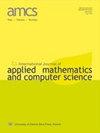利用输出集合的变换提高粉状FSMS的LUT计数
IF 1.2
4区 计算机科学
Q3 AUTOMATION & CONTROL SYSTEMS
International Journal of Applied Mathematics and Computer Science
Pub Date : 2022-09-01
DOI:10.34768/amcs-2022-0035
引用次数: 1
摘要
提出了一种将输出集合转换为状态码的方法,以减少基于fpga的Mealy有限状态机(fsm)电路中lut的数量。减少是由于使用双组分状态代码。与基于扩展代码的fsm相比,这种方法可以减少状态变量的数量。在生成的FSM电路中有三个级别的lut。每个部分函数由一个单lut电路表示。通过一个综合实例说明了该方法。这些实验是使用标准基准进行的。他们表明,与其他研究方法(Vivado的Auto和One-hot, JEDI以及将输出集合代码转换为扩展状态代码)相比,所提出的方法产生的FSM电路具有显着更小的LUT计数。LUT计数平均从9.86%下降到59.64%。LUT计数的改进伴随着性能的略微改进。最大工作频率平均由2.74%提高到12.93%。随着FSM输入值和状态变量的增加,该方法的优点变得更加明显。本文章由计算机程序翻译,如有差异,请以英文原文为准。
Improving the LUT Count for Mealy FSMS with Transformation of Output Collections
Abstract A method is proposed which aims at reducing the number of LUTs in the circuits of FPGA-based Mealy finite state machines (FSMs) with transformation of collections of outputs into state codes. The reduction is achieved due to the use of two-component state codes. Such an approach allows reducing the number of state variables compared with FSMs based on extended codes. There are exactly three levels of LUTs in the resulting FSM circuit. Each partial function is represented by a single-LUT circuit. The proposed method is illustrated with an example of synthesis. The experiments were conducted using standard benchmarks. They show that the proposed method produces FSM circuits with significantly smaller LUT counts compared with those produced by other investigated methods (Auto and One-hot of Vivado, JEDI, and transformation of output collection codes into extended state codes). The LUT count is decreased by, on average, from 9.86% to 59.64%. The improvement of the LUT count is accompanied by a slightly improved performance. The maximum operating frequency is increased, on average, from 2.74% to 12.93%. The advantages of the proposed method become more pronounced with increasing values of FSM inputs and state variables.
求助全文
通过发布文献求助,成功后即可免费获取论文全文。
去求助
来源期刊
CiteScore
4.10
自引率
21.10%
发文量
0
审稿时长
4.2 months
期刊介绍:
The International Journal of Applied Mathematics and Computer Science is a quarterly published in Poland since 1991 by the University of Zielona Góra in partnership with De Gruyter Poland (Sciendo) and Lubuskie Scientific Society, under the auspices of the Committee on Automatic Control and Robotics of the Polish Academy of Sciences.
The journal strives to meet the demand for the presentation of interdisciplinary research in various fields related to control theory, applied mathematics, scientific computing and computer science. In particular, it publishes high quality original research results in the following areas:
-modern control theory and practice-
artificial intelligence methods and their applications-
applied mathematics and mathematical optimisation techniques-
mathematical methods in engineering, computer science, and biology.

 求助内容:
求助内容: 应助结果提醒方式:
应助结果提醒方式:


